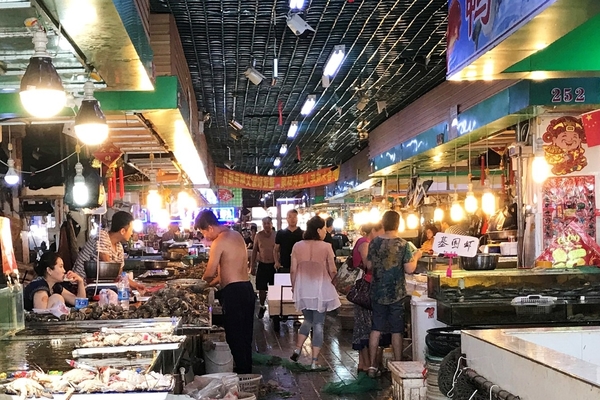Balancing economic, cultural, and public health concerns in Chinese wet markets

A wet market in Dandong, Liaoning Province, China. Credit: Philip Wen/Reuters
By Nick Mitilenes, MBA/MS ’21;
Trishul Patel MBA/MS ’20;
and James Sang ’94 (A&S), MBA/MS ’20
When you hear “wet market,” what does that mean to you? Perhaps dingy conditions, dim lighting, or poor customer service. Maybe your mind goes straight to poverty. Wet markets, such as the Huanan Seafood Wholesale Market in Wuhan, China, have been the beneficiary of substantial media attention since the spread of SARS-CoV-2, or COVID-19, but what exactly is a wet market?
Wet markets seem to have many definitions or origins of the term. The hosing down of perishables with water to keep them fresh is one such origin, but broadly speaking a wet market offers perishable items. Based on this, La Boqueria in Barcelona is a wet market, as is the relocated Tsukiji Fish Market in Tokyo, now called Toysu Market, after $5 billion of investment. These tourist attractions are celebrated—not thought of as sources of exotic disease. Wet markets are a primary source of food in many parts of the world, especially prominent in emerging markets in Asia, representing a massive industry and significant area of spending for the average low-income individual.
Outside of Asia, though, wet markets take many forms. Since wet markets simply involve the sale of perishable items, quite a large number of markets would qualify, from a farmers market in the United States to live fish markets in Peru and Greece. Once you come to understand the vast world of wet markets, you start to see a spectrum emerge. The beginnings of COVID-19 didn’t come from local fruit that sat out too long. Navigating the intersection of this sinister disease and wet markets requires careful consideration of economics, culture, and public health, all of which are in careful balance for the vast majority of these markets worldwide.
The introduction of the notorious 120-nanometer virus that has upended daily life for billions and killed thousands is still unknown. Several theories have been proposed, with one of the most popular being that COVID-19, a zoonotic virus, was originally transmitted from animals to humans at the Huanan Market in Wuhan. Its origin is hard to argue as next-generation sequencing has shown significant genetic similarity to coronaviruses in bats; though, the jump to humans and evolution of its pathogenicity is still under debate. This doesn’t come as a surprise to students of virology and epidemiology who have long observed bats as reservoirs of various coronaviruses as well as other infamous diseases such as rabies and Ebola. So, what’s the connection to wet markets?
As we know, not all wet markets are created equal. The $73 billion Chinese exotic animal market (2017) combined with unregulated slaughter of common fowl and swine, often come together in Chinese wet markets. Unlike Hong Kong SAR, where the Slaughterhouse Regulation prohibits the unregulated slaughter of wild animals, aerosolization of biological fluids occurs on a regular basis at many other markets as local butchers perform their services for customers who like their protein farm fresh. If crowded, often unsanitary conditions isn’t enough to make a public health officer cringe, the mingling of people and animals in these markets certainly puts them over the top.
Picture it: bat transmits to animal, animal transmits to human, and just a few months later a health crisis of epic proportions is upon us. Recent decisions, therefore, to ban the sale and/or slaughter of animals, especially exotic ones, seem to make sense when you consider that our not-so-friendly, disease-carrying bats either transmit their payload to these animals in advance or potentially when flying through an open-air market. Some haven’t stopped there, though.
The economic, social, and cultural value of wet markets
In Western media, there is a call for the shutdown of wet markets due to the misconceived notion that all wet markets are a source of infectious outbreaks. The shutdown of these wet markets will have economic, social, and cultural implications, which range from rising poverty among rural farmers, to lack of access to fresh food products, and to disruption in the traditional Chinese medicine industry. In addition, this can drive the wild animal trade and sale to underground markets, where regulation would be difficult.
Wet markets play an important role in the Chinese food market industry and Chinese social life and culture. Chinese wet markets traditionally serve as venues where fresh produce, seafood, and meat can be obtained. Although people in urban areas have access to refrigeration, some people who live in small residences cannot accommodate larger-size refrigerators. Many rural- or low-income people do not have access to refrigeration. Hence, many people in the urban, rural, and low-income areas are dependent on wet markets for fresh food products. Since many of the low-income people cannot afford the food prices in Chinese supermarkets, wet markets also offer an alternative and more affordable access to various food products.
There are some wet markets that sell wild animals. The wet markets that sell wild animals are not very common and people will have to travel to specific sites in urban and rural areas to find wild animal products. These specific wet markets serve as a venue for wild animal access and trade. Wild animal consumption became part of the Chinese diet through necessity in times of famine, especially during the Communist Party takeover. Although wild animal consumption is less popular among younger generations, it is still practiced by older generations in rural areas. Wild animal breeding was utilized to help increase the Chinese food supply. In addition, the Chinese government had previously utilized wild animal breeding to address rural farming development and poverty issues.
As mentioned earlier, wet markets play a role in the Chinese social life and culture. Traditionally, Chinese people prefer fresh produce and meats due to better taste, food safety, and the fact that they are healthier than frozen, pre-packaged food products. Additionally, a series of incidents, in which Chinese supermarket products caused food poisoning and gastroenteritis, have driven people to purchase fresh food products in the wet markets for safety reasons. In Chinese social life, the consumption of certain wild animals is often associated with affluence and prosperity due to their exoticness, novelty, and often expensive nature. Culturally, many wild animal parts are used as ingredients in traditional Chinese medicine. Elements of wild animals are deemed to have properties that boost the immune system.
A fresh approach with social ranking
While policies and regulations are in place for these wet markets, they are not well enforced. To ensure there is no food safety risk, policy coupled with a reliable enforcement plan is essential. This is especially important considering Chinese municipal governments are supporting the development of new wet markets. In these markets, there are instances where vendors do not meet minimum requirements (conditions for storage, transfer, handling, etc.) and other instances where the selling of certain animal species is outright illegal. The consequence: a global pandemic. We can think of many reasons why enforcement falls short, but the result is the same. That is, vendors in wet markets are not incentivized enough to follow policy, particularly those for wild animals and live chicken. The good news is that these vendors represent a small and niche part of wet markets. What, then, are the alternatives?
China’s social credit system (a national reputation system) is a database designed to monitor real-time government, corporate, and individual behavior. Version one, containing only parts of the envisioned system, was released by the Chinese government as an opt-in system in 2014. The full system is expected to be rolled out nationwide throughout 2020. In addition to monitoring traditional credit, its aim is to leverage big data to score entities based on their compliance with regulations, laws, and directives. The scores are then to be used to invoke a variety of rewards and punishments, all to promote a high-trust society. For businesses, it’s supposed to include the ratings of product quality and service. Additionally, even if a company meets all of its legal obligations, it will still be penalized if it does business with a company on a blacklist. For individuals, it goes a step further by using face and voice recognition technology to identify a range of behavior such as jaywalking to dissident political activity. There are many components of the system not discussed here, as well as variances by region, including mixed system backends between private and public datasets. We have highlighted elements of the system as they might relate to the wet markets, specifically individuals and businesses.
The aforementioned features are slated for the nationwide system and hence could play a viable role in regulating the wet markets. Converse to the status quo, these systems offer the differentiating element of reputation scoring. Another key element is the versatility of the system. By being able to respond to changing environments and behaviors it has the agility to support an evolving society. Recently, in the wake of the COVID-19 virus, the Beijing and Shanghai governments adapted the system to prevent price gouging of medical products, as well as the sale of counterfeit medical products. As the scores and ultimately reputation impacts an individual’s way of life and a business’s ability to conduct ordinary business, entities are organically incentivized to remain compliant. But, is this enough to prevent the next coronavirus?




1 Comment
Lindsey Dru
Very well done. Thank you for highlighting the social aspects of wet markets, and educating all.
Comments are closed.